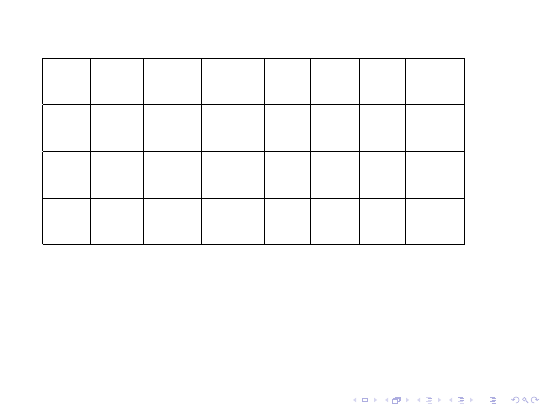
Čeština — The Czech Language
DIMACS REU
July 11, 2006

History and Relationships
I
Indo-European language
I
Slavic language
I
Mutually intelligible with Slovak, Upper Sorbian, similar to
Polish

History and Relationships
I
Indo-European language
I
Slavic language
I
Mutually intelligible with Slovak, Upper Sorbian, similar to
Polish

History and Relationships
I
Indo-European language
I
Slavic language
I
Mutually intelligible with Slovak, Upper Sorbian, similar to
Polish

Pronunciation
I
Spelling is phonetic
I
Stress is on the first syllable
I
Few exceptions

Pronunciation
I
Spelling is phonetic
I
Stress is on the first syllable
I
Few exceptions

Pronunciation
I
Spelling is phonetic
I
Stress is on the first syllable
I
Few exceptions

Czech letters
A
B
C
Č
D
Ď
E
F
Arm
Big
bliTZ
CHeck
Dig
bEll
Food
G
H
CH
I
J
K
L
M
Go
Ham
loCH
bIt
Yell
Kid
Low
Mop
N
Ň
O
P
R
Ř
S
Š
No
ÑiÑo
rOck
Pit
Rid
Sea
SHop
T
Ť
U
V
X
Y
Z
Ž
Tip
bOOk
Van
boX
verY
Zip
viSIon
Notes:
I
“Accents” on vowels (Á É Í Ó Ú Ý) make them longer
I
Ů is the same thing as Ú
I
Q and W only appear in loanwords
I
I and Y are pronounced in the same way

Czech letters
A
B
C
Č
D
Ď
E
F
Arm
Big
bliTZ
CHeck
Dig
bEll
Food
G
H
CH
I
J
K
L
M
Go
Ham
loCH
bIt
Yell
Kid
Low
Mop
N
Ň
O
P
R
Ř
S
Š
No
ÑiÑo
rOck
Pit
Rid
Sea
SHop
T
Ť
U
V
X
Y
Z
Ž
Tip
bOOk
Van
boX
verY
Zip
viSIon
Notes:
I
“Accents” on vowels (Á É Í Ó Ú Ý) make them longer
I
Ů is the same thing as Ú
I
Q and W only appear in loanwords
I
I and Y are pronounced in the same way

Czech letters
A
B
C
Č
D
Ď
E
F
Arm
Big
bliTZ
CHeck
Dig
bEll
Food
G
H
CH
I
J
K
L
M
Go
Ham
loCH
bIt
Yell
Kid
Low
Mop
N
Ň
O
P
R
Ř
S
Š
No
ÑiÑo
rOck
Pit
Rid
Sea
SHop
T
Ť
U
V
X
Y
Z
Ž
Tip
bOOk
Van
boX
verY
Zip
viSIon
Notes:
I
“Accents” on vowels (Á É Í Ó Ú Ý) make them longer
I
Ů is the same thing as Ú
I
Q and W only appear in loanwords
I
I and Y are pronounced in the same way

Czech letters
A
B
C
Č
D
Ď
E
F
Arm
Big
bliTZ
CHeck
Dig
bEll
Food
G
H
CH
I
J
K
L
M
Go
Ham
loCH
bIt
Yell
Kid
Low
Mop
N
Ň
O
P
R
Ř
S
Š
No
ÑiÑo
rOck
Pit
Rid
Sea
SHop
T
Ť
U
V
X
Y
Z
Ž
Tip
bOOk
Van
boX
verY
Zip
viSIon
Notes:
I
“Accents” on vowels (Á É Í Ó Ú Ý) make them longer
I
Ů is the same thing as Ú
I
Q and W only appear in loanwords
I
I and Y are pronounced in the same way

Difficulties and special rules
I
Ě is pronounced like E but modifies the preceding consonant:
DĚ, NĚ, TĚ is like ĎE, ŇE, ŤE
BĚ, FĚ, PĚ, VĚ is like BJE, FJE, PJE, VJE
MĚ is like MŇE
I
DI, NI, TI is pronounced as ĎI, ŇI, ŤI (except in loanwords)
I
consonant (de)voicing: rod -> rot,
I
R and L (and less often M) may act as syllabic consonants:
I
scvrnkls
I
čtvrthrst
I
Smrž pln skvrn zvlhl z mlh. Krt prskl, skrz drn prchl v prsť.
I
Ř

Difficulties and special rules
I
Ě is pronounced like E but modifies the preceding consonant:
DĚ, NĚ, TĚ is like ĎE, ŇE, ŤE
BĚ, FĚ, PĚ, VĚ is like BJE, FJE, PJE, VJE
MĚ is like MŇE
I
DI, NI, TI is pronounced as ĎI, ŇI, ŤI (except in loanwords)
I
consonant (de)voicing: rod -> rot,
I
R and L (and less often M) may act as syllabic consonants:
I
scvrnkls
I
čtvrthrst
I
Smrž pln skvrn zvlhl z mlh. Krt prskl, skrz drn prchl v prsť.
I
Ř

Difficulties and special rules
I
Ě is pronounced like E but modifies the preceding consonant:
DĚ, NĚ, TĚ is like ĎE, ŇE, ŤE
BĚ, FĚ, PĚ, VĚ is like BJE, FJE, PJE, VJE
MĚ is like MŇE
I
DI, NI, TI is pronounced as ĎI, ŇI, ŤI (except in loanwords)
I
consonant (de)voicing: rod -> rot,
I
R and L (and less often M) may act as syllabic consonants:
I
scvrnkls
I
čtvrthrst
I
Smrž pln skvrn zvlhl z mlh. Krt prskl, skrz drn prchl v prsť.
I
Ř

Difficulties and special rules
I
Ě is pronounced like E but modifies the preceding consonant:
DĚ, NĚ, TĚ is like ĎE, ŇE, ŤE
BĚ, FĚ, PĚ, VĚ is like BJE, FJE, PJE, VJE
MĚ is like MŇE
I
DI, NI, TI is pronounced as ĎI, ŇI, ŤI (except in loanwords)
I
consonant (de)voicing: rod -> rot,
I
R and L (and less often M) may act as syllabic consonants:
I
scvrnkls
I
čtvrthrst
I
Smrž pln skvrn zvlhl z mlh. Krt prskl, skrz drn prchl v prsť.
I
Ř

Difficulties and special rules
I
Ě is pronounced like E but modifies the preceding consonant:
DĚ, NĚ, TĚ is like ĎE, ŇE, ŤE
BĚ, FĚ, PĚ, VĚ is like BJE, FJE, PJE, VJE
MĚ is like MŇE
I
DI, NI, TI is pronounced as ĎI, ŇI, ŤI (except in loanwords)
I
consonant (de)voicing: rod -> rot,
I
R and L (and less often M) may act as syllabic consonants:
I
scvrnkls
I
čtvrthrst
I
Smrž pln skvrn zvlhl z mlh. Krt prskl, skrz drn prchl v prsť.
I
Ř

Difficulties and special rules
I
Ě is pronounced like E but modifies the preceding consonant:
DĚ, NĚ, TĚ is like ĎE, ŇE, ŤE
BĚ, FĚ, PĚ, VĚ is like BJE, FJE, PJE, VJE
MĚ is like MŇE
I
DI, NI, TI is pronounced as ĎI, ŇI, ŤI (except in loanwords)
I
consonant (de)voicing: rod -> rot,
I
R and L (and less often M) may act as syllabic consonants:
I
scvrnkls
I
čtvrthrst
I
Smrž pln skvrn zvlhl z mlh. Krt prskl, skrz drn prchl v prsť.
I
Ř

Difficulties and special rules
I
Ě is pronounced like E but modifies the preceding consonant:
DĚ, NĚ, TĚ is like ĎE, ŇE, ŤE
BĚ, FĚ, PĚ, VĚ is like BJE, FJE, PJE, VJE
MĚ is like MŇE
I
DI, NI, TI is pronounced as ĎI, ŇI, ŤI (except in loanwords)
I
consonant (de)voicing: rod -> rot,
I
R and L (and less often M) may act as syllabic consonants:
I
scvrnkls
I
čtvrthrst
I
Smrž pln skvrn zvlhl z mlh. Krt prskl, skrz drn prchl v prsť.
I
Ř

Difficulties and special rules
I
Ě is pronounced like E but modifies the preceding consonant:
DĚ, NĚ, TĚ is like ĎE, ŇE, ŤE
BĚ, FĚ, PĚ, VĚ is like BJE, FJE, PJE, VJE
MĚ is like MŇE
I
DI, NI, TI is pronounced as ĎI, ŇI, ŤI (except in loanwords)
I
consonant (de)voicing: rod -> rot,
I
R and L (and less often M) may act as syllabic consonants:
I
scvrnkls
I
čtvrthrst
I
Smrž pln skvrn zvlhl z mlh. Krt prskl, skrz drn prchl v prsť.
I
Ř

Grammar – the difficult parts
I
Nouns have genders (feminine, masculine, neuter)
I
Adjectives, pronouns, verbs take different forms depending on
the gender of the noun they refer to.
I
Nouns, pronouns and adjectives have declensions (seven cases,
14 declension paradigms for nouns, many exceptions)
I
Verbs have (nontrivial) conjugations: lots of conjugation
paradigms (I don’t know how many), irregular verbs.
I
Words often take prefixes, which modify the meaning, often in
a nonintuitive way: být (to be), nabýt (to obtain), ubýt (to
diminish), pobýt (to stay), dobýt (to conquer), pozbýt (to
lose), zbýt (to remain), přebýt (to be a surplus).

Grammar – the difficult parts
I
Nouns have genders (feminine, masculine, neuter)
I
Adjectives, pronouns, verbs take different forms depending on
the gender of the noun they refer to.
I
Nouns, pronouns and adjectives have declensions (seven cases,
14 declension paradigms for nouns, many exceptions)
I
Verbs have (nontrivial) conjugations: lots of conjugation
paradigms (I don’t know how many), irregular verbs.
I
Words often take prefixes, which modify the meaning, often in
a nonintuitive way: být (to be), nabýt (to obtain), ubýt (to
diminish), pobýt (to stay), dobýt (to conquer), pozbýt (to
lose), zbýt (to remain), přebýt (to be a surplus).

Grammar – the difficult parts
I
Nouns have genders (feminine, masculine, neuter)
I
Adjectives, pronouns, verbs take different forms depending on
the gender of the noun they refer to.
I
Nouns, pronouns and adjectives have declensions (seven cases,
14 declension paradigms for nouns, many exceptions)
I
Verbs have (nontrivial) conjugations: lots of conjugation
paradigms (I don’t know how many), irregular verbs.
I
Words often take prefixes, which modify the meaning, often in
a nonintuitive way: být (to be), nabýt (to obtain), ubýt (to
diminish), pobýt (to stay), dobýt (to conquer), pozbýt (to
lose), zbýt (to remain), přebýt (to be a surplus).

Grammar – the difficult parts
I
Nouns have genders (feminine, masculine, neuter)
I
Adjectives, pronouns, verbs take different forms depending on
the gender of the noun they refer to.
I
Nouns, pronouns and adjectives have declensions (seven cases,
14 declension paradigms for nouns, many exceptions)
I
Verbs have (nontrivial) conjugations: lots of conjugation
paradigms (I don’t know how many), irregular verbs.
I
Words often take prefixes, which modify the meaning, often in
a nonintuitive way: být (to be), nabýt (to obtain), ubýt (to
diminish), pobýt (to stay), dobýt (to conquer), pozbýt (to
lose), zbýt (to remain), přebýt (to be a surplus).

Grammar – the difficult parts
I
Nouns have genders (feminine, masculine, neuter)
I
Adjectives, pronouns, verbs take different forms depending on
the gender of the noun they refer to.
I
Nouns, pronouns and adjectives have declensions (seven cases,
14 declension paradigms for nouns, many exceptions)
I
Verbs have (nontrivial) conjugations: lots of conjugation
paradigms (I don’t know how many), irregular verbs.
I
Words often take prefixes, which modify the meaning, often in
a nonintuitive way: být (to be), nabýt (to obtain), ubýt (to
diminish), pobýt (to stay), dobýt (to conquer), pozbýt (to
lose), zbýt (to remain), přebýt (to be a surplus).

Grammar – the easy parts
I
No articles (‘the’,‘a’)
I
Only three tenses (past, present, future)
I
No special grammar forms to express continuity (we go vs. we
are going), completive and imperfective verbs used instead
I
Flexible word order

Grammar – the easy parts
I
No articles (‘the’,‘a’)
I
Only three tenses (past, present, future)
I
No special grammar forms to express continuity (we go vs. we
are going), completive and imperfective verbs used instead
I
Flexible word order

Grammar – the easy parts
I
No articles (‘the’,‘a’)
I
Only three tenses (past, present, future)
I
No special grammar forms to express continuity (we go vs. we
are going), completive and imperfective verbs used instead
I
Flexible word order

Grammar – the easy parts
I
No articles (‘the’,‘a’)
I
Only three tenses (past, present, future)
I
No special grammar forms to express continuity (we go vs. we
are going), completive and imperfective verbs used instead
I
Flexible word order

Flexible word order
English: Alice gave Bob a book.
Czech:
Alice dala Bobovi knihu.
Bobovi dala Alice knihu.
Alice knihu dala Bobovi.
Bobovi knihu dala Alice.
Alice Bobovi dala knihu.
Bobovi Alice dala knihu.
Knihu Alice dala Bobovi.
Knihu Bobovi dala Alice.
Alice Bobovi knihu dala.
Bobovi Alice knihu dala.
Alice dala knihu Bobovi.
Bobovi dala knihu Alice.
Knihu dala Alice Bobovi.
Knihu dala Bobovi Alice.
Knihu Alice Bobovi dala.
Knihu Bobovi Alice dala.
Alice knihu Bobovi dala.
Bobovi knihu Alice dala.

Word order changes emphasis
Dala Alice Bobovi knihu? (Did Alice give Bob a book?)
Dala Alice knihu Bobovi? (Did Alice give the book to Bob?)
Dala Bobovi Alice knihu? (Did Alice give the book to Bob?)
Dala Bobovi knihu Alice? (Was it Alice, who gave a book to Bob?)
Dala knihu Alice Bobovi? (Was it Bob, who got Alice’s book?)
Dala knihu Bobovi Alice? (Was it Alice, who gave a book to Bob?)

Words of Czech origin
I
pistol: from the Czech word “píšťala”, which means “pipe”
I
robot: coined by Josef Čapek, derived from “robota”
I
dollar: from the word “tolar” (or “taler” in German) – a coin
made in Joachimsthal.

Words of Czech origin
I
pistol: from the Czech word “píšťala”, which means “pipe”
I
robot: coined by Josef Čapek, derived from “robota”
I
dollar: from the word “tolar” (or “taler” in German) – a coin
made in Joachimsthal.

Words of Czech origin
I
pistol: from the Czech word “píšťala”, which means “pipe”
I
robot: coined by Josef Čapek, derived from “robota”
I
dollar: from the word “tolar” (or “taler” in German) – a coin
made in Joachimsthal.

Links
www.omniglot.com
www.locallingo.com
www.bohemica.com
Wyszukiwarka
Podobne podstrony:
A practical grammar of the Latin languag
12 The Czech republic1416
The Community Language Learning
An Elementary Grammar of the Icelandic Language
ebook The Secret Language of Women
THE HISTORY OF THE ENGLISH LANGUAGE 2
the spanish language article, języki obce, hiszpański, Język hiszpański
12 the czech republic
THE HISTORY OF THE ENGLISH LANGUAGE OE NOMINAL INFLECTION 5
12 the Czech republic
4 Theories of the Second Language?quisition
eReport Wine Glossary Drinking in the Greek Language
12 The Czech Republic1417
3 Theories of the First language?quisition
THE HISTORY OF THE ENGLISH LANGUAGE 1
the english language amendment B43R72DD77FWAIZ4OYBJAMB23GABC4EZ75ZKAFA
A practical grammar of the Latin languag
06 The Korean Language Structure, Use and Context
więcej podobnych podstron